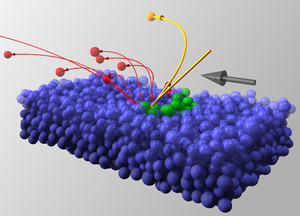Colliding Grains Make Stronger Sandstorms
In a sandstorm, midair collisions between particles dramatically increase the flow of grains within the storm, rather than hindering the flow, according to a report in Physical Review Letters. This surprising result comes from 3D simulations where the researchers compared runs with and without midair collisions. They found that collisions allow high-speed particles to be “recruited” more effectively from the lower speed particles near the ground. The finding suggests that accurate sandstorm modeling must account for these collisions, which have been ignored by other models. Sandstorms and similar processes reshape landscapes on earth and on other planets, so improving models may be important for a wide range of geoscience research.
Sand grains are whipped into the air during a storm by a process called saltation. The storm creates a dense, roiling bed of grains at ground level, perhaps a few centimeters thick. Some of these grains, called saltons, get kicked high above the bed, where wind speeds are higher, and are accelerated so much that they can slam back into the bed and generate a “splash” of other grains. Some of the ejected grains are then caught by the wind and become new saltons. While saltons are a small fraction of the total (most grains are in the bed), they make up most of the visible grains in a sandstorm.
Previous computer simulations studying the role of midair collisions—those taking place above the bed—had been hampered by huge computational requirements. Hans Herrmann of the Institute for Building Materials in Zurich and his colleagues developed a 3D simulation that included such collisions, although it required some simplifications in the treatment of the wind. The computer code also allowed the team to vary the amount of kinetic energy a grain retained after a collision.
The team monitored the flux, a measure of the storm’s strength, defined as the number of grains passing through a fixed area inside the storm. Surprisingly, when midair collisions were switched on, the overall flux increased by up to threefold. “This result is counterintuitive,” Herrmann says. “One would naively expect that collisions between grains would shorten [their] trajectories,” not lengthen them. Herrmann and his colleagues also found that the flux was maximized if the simulation required grains to lose about of their speed in each collision, rather than retaining all of their kinetic energy. Overall, they found that midair collisions were an important part of the saltation process.
To explain their results, the team points to “leapers,” grains that are kicked up by salton splashes but not high enough to become saltons. In the event that two leapers collide, one can be boosted higher into the air, where it can collide with yet another particle and be boosted even higher. Eventually, it can rise high enough and gain enough speed from the wind to be classified as a salton, meaning it can generate more saltons when it slams back into the bed. This seemingly unlikely sequence turns out to be a common occurrence because the density of grains in a sandstorm is so high.
The researchers also found that when a pair of grains lose some speed from a collision, they are more likely to exit the interaction in similar directions than if the collision were perfectly elastic. This partial alignment increases flux, they say, which explains why the peak flux occurred when the simulation required that collisions slow particles down.
Jasper Kok of the University of California, Los Angeles, says that these results will likely influence how researchers model these systems in the future. He says Herrmann and his colleagues have “looked at [the problem] really carefully, with a really good model, trying to capture it in intuitive physics.” However, verifying the model may be difficult, says Kok, since one can’t control collisions in experiments. Kok says a better understanding of the flux generated by a storm is “massively important,” since particles from these storms melt snow, obscure solar radiation, and reshape beaches.
–Trevor Quirk
Trevor Quirk is a freelance science writer in Saratoga Springs, New York.





